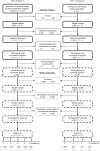Breast-feeding promotion in hospitals and prospective breast-feeding rates during the first year of life in two national surveys 1997-1998 and 2017-2019 in Germany
- PMID: 33722333
- PMCID: PMC10195543
- DOI: 10.1017/S1368980021001099
Breast-feeding promotion in hospitals and prospective breast-feeding rates during the first year of life in two national surveys 1997-1998 and 2017-2019 in Germany
Abstract
Objectives: The present study aimed to assess the current state of breast-feeding promotion in hospitals and the prevalence of breast-feeding during the first year of life in Germany and to compare the results with a study 20 years earlier.
Design: In the studies on 'breast-feeding and infant nutrition in Germany' named 'SuSe', a cross-sectional survey in hospitals was combined with a subsequent prospective survey of breast-feeding and infant nutrition during the first year of life (0·5, 2, 4, 6 and 12 months after birth) in mother-infant pairs who were recruited in the hospitals. Written questionnaires and phone calls were used in SuSe I and web-based questionnaires in SuSe II. Breast-feeding promotion and prevalence were evaluated using recommendations from the WHO and the UNICEF.
Setting: Two nationwide surveys SuSe I (1997-1998) and SuSe II (2017-2019).
Participants: In SuSe I, 177 hospitals and 1717 mother-infant pairs and in SuSe II 109 hospitals and 962 mother-infant pairs were included.
Results: In SuSe II, hospitals implemented seven of the WHO 'Ten Steps to Successful Breastfeeding' to a greater extent than the hospitals in SuSe I. More mothers exclusively breastfed for 4 months (57 % v. 33 %) and continued breast-feeding until 6 (78 % v. 48 %) and 12 months (41 % v. 13 %). In both studies, exclusive breast-feeding decreased between 4 and 6 months of age due to the introduction of complementary feeding.
Conclusions: In Germany, breast-feeding habits have come closer to the recommendations over the last 20 years.
Keywords: Breast-feeding assessment; Breast-feeding indicators; Exclusive breast-feeding; Maternity hospitals; WHO Ten Steps.
Figures
Similar articles
-
The role of breastfeeding promotion in German hospitals for exclusive breastfeeding duration.Matern Child Nutr. 2022 Apr;18(2):e13326. doi: 10.1111/mcn.13326. Epub 2022 Jan 25. Matern Child Nutr. 2022. PMID: 35080138 Free PMC article.
-
Assessment of breast-feeding promotion in hospitals and follow-up survey of mother-infant pairs in Germany: the SuSe Study.Public Health Nutr. 2002 Aug;5(4):547-52. doi: 10.1079/PHN2001321. Public Health Nutr. 2002. PMID: 12186663
-
Do baby-friendly hospitals influence breastfeeding duration on a national level?Pediatrics. 2005 Nov;116(5):e702-8. doi: 10.1542/peds.2005-0537. Pediatrics. 2005. PMID: 16263985
-
Breastfeeding promotion and priority setting in health.Health Policy Plan. 1996 Jun;11(2):156-68. doi: 10.1093/heapol/11.2.156. Health Policy Plan. 1996. PMID: 10158457 Review.
-
Nutrition: basis for healthy children and mothers in Bangladesh.J Health Popul Nutr. 2008 Sep;26(3):325-39. doi: 10.3329/jhpn.v26i3.1899. J Health Popul Nutr. 2008. PMID: 18831228 Free PMC article. Review.
Cited by
-
Breastfeeding rates in Israel and their health policy implications.Isr J Health Policy Res. 2025 May 13;14(1):28. doi: 10.1186/s13584-025-00689-1. Isr J Health Policy Res. 2025. PMID: 40361190 Free PMC article.
-
Effect of care intervention with a health education form for breastfeeding on breast distension, pain, and lactation in postpartum mothers.World J Clin Cases. 2024 Aug 6;12(22):5059-5066. doi: 10.12998/wjcc.v12.i22.5059. World J Clin Cases. 2024. PMID: 39109040 Free PMC article. Clinical Trial.
-
Adherence to recommendations for nutrient supplementation related to pregnancy in Germany.Food Sci Nutr. 2023 Jun 11;11(9):5236-5247. doi: 10.1002/fsn3.3482. eCollection 2023 Sep. Food Sci Nutr. 2023. PMID: 37701189 Free PMC article.
-
The role of breastfeeding promotion in German hospitals for exclusive breastfeeding duration.Matern Child Nutr. 2022 Apr;18(2):e13326. doi: 10.1111/mcn.13326. Epub 2022 Jan 25. Matern Child Nutr. 2022. PMID: 35080138 Free PMC article.
-
How can we support the individual breastfeeding experience? Quantitative results from a mixed-methods study.Int Breastfeed J. 2025 May 17;20(1):38. doi: 10.1186/s13006-025-00726-4. Int Breastfeed J. 2025. PMID: 40382664 Free PMC article.
References
-
- World Health Organization/United Nations Children’s Fund (1990) Innocenti declaration on the protection, promotion and support of breastfeeding. http://worldbreastfeedingweek.org/2018/wp-content/uploads/2018/07/1990-I... (accessed October 2020).
-
- Agostoni C, Braegger C, Decsi T et al. (2009) Breast-feeding: a commentary by the ESPGHAN committee on nutrition. J Pediatr Gastroenterol Nutr 49, 112–125. - PubMed
-
- Koletzko B, Bauer CP, Brönstrup A et al. (2013) Infant nutrition and nutrition for breastfeeding mothers. Updated practice recommendations of the network “Healthy Start—Young Family Network” a project from IN FORM. Monatsschr Kinderheilkd 161, 237–246.
-
- Horta BL & Victora CG (2013) Short-Term Effects of Breastfeeding: A Systematic Review of the Benefits of Breastfeeding on Diarrhoea and Pneumonia Mortality. Geneva: World Health Organization.
-
- Victora CG, Bahl R, Barros AJ et al. (2016) Breastfeeding in the 21st century: epidemiology, mechanisms and lifelong effect. Lancet 387, 475–490. - PubMed
Publication types
MeSH terms
LinkOut - more resources
Full Text Sources
Other Literature Sources
Medical


